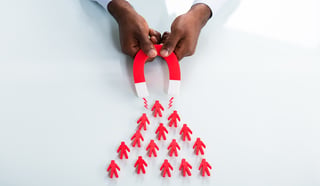Growth Insights for CEOs

Outsider Insights | From Hustle to System: Why More CEOs Are Rebuilding Their Sales Function
Outsider Insights
Across Chief Outsiders, we talk to hundreds of CEOs every month. In this new series, we explore the trends and challenges we’re hearing from these discussions – and what you can do if you’re facing the same issues in your business.
Recent Posts

Go-to-Market Security Issues Every SMB CEO or Sales/Marketing Exec Needs to Prevent
Tue, Oct 8, 2019 — Five Key Areas You Must Proactively Manage Mark Coronna, Area Managing Partner & CMO, Chief Outsiders with Mark Sheehan, Principal & CIO/CISO, Stowell Solutions Group This article is a practical guide to being proactive in preventing security issues in your go-to-market (Sales and Marketing) programs and operations. There are many services to use once you have an issue, but in this article, we are offering a checklist of things to do to help reduce your risk of significant incidents that could damage your brand, reputation, revenue, and business valuation. We think it’s better to be proactive than have to react to security events.

Why a “Failure to Communicate” is a First Step to Going Out of Business
Wed, Sep 25, 2019 — What Business Execs Can Learn About the Power of Authentic Conversations Mark Coronna, Area Managing Partner & CMO, Chief Outsiders with Matt McKnight, President, McKnight Advisors If you’ve ever seen the Paul Newman movie Cool Hand Luke, you might remember the hard-boiled egg eating contest, but that’s another subject. The iconic line we all remember, after several failed attempts to bring Luke in line, is when the prison warden remarks, “What we have here is a failure to communicate.” Knowledge, open communications, as well as procrastination are highly linked to business performance. Having hands-on and personal real-time knowledge of what’s going on in your business is a challenge and having the confidence and willingness to do something about what you’ve learned is another.

How to Retain Customers and Develop Brand Advocates - Part 2
Fri, Sep 13, 2019 — Part 2 of 3: Developing a Retention Marketing Program As we learned in my previous post, retention marketing encompasses the activities associated with retaining customers or increasing customer value through re-purchasing and up-selling products and services. It’s anywhere from five to 25 times less expensive than acquisition marketing—and done well can reduce the expense pressure of acquisition marketing to grow your business. Retention marketing should be a part of any business growth strategy. Retention marketing involves communicating with your customers in a way that helps you nurture and keep them. This should be an ongoing priority for the business with buy-in from the top throughout the entire organization. After all, you’ve all worked hard and spent a lot of money to acquire those customers.
Stay up-to-date with the latest from Chief Outsiders

How to Retain Customers and Develop Brand Advocates - Part 1
Fri, Sep 6, 2019 — Part 1 of 3: Why retention marketing should be part of your growth strategy If you are losing customers at almost any rate, you are jeopardizing your business growth strategy. Every lost customer creates a hole that you must fill before you can claim any new customer growth. The more customers you churn, the deeper the gap before you can realize any revenue or profit growth.

Is Subscription Pricing Right for your Business? Four Tests To Reveal the Answer
Wed, Sep 4, 2019 — A long time ago, in a galaxy far away, most consumer enterprises were in the business of selling physical items that could be held, consumed, and bought again. Whether it was a cheeseburger at McDonalds, a quart of milk at the grocery store, or a stamping machine from an industrial supplier, the pricing model was simple: Take the cost to produce, add profit (plus padding for high market demand), and you’re done. Ship one unit, charge for one unit. Simple.

The Millennial Food Shift: How CPG Food Companies Can Rescue Their Market
Wed, Aug 28, 2019 — Never before has the kitchen been so lifeless. For generations, the once-centerpiece of the American home has become much less important – marginalized by Millennials and younger generations who choose to order up their nourishment with a few silent taps of the cell phone rather than the clank of pots and pans. Seemingly overnight, this phase shift in eating habits has roiled the business models of food-oriented consumer packaged goods (CPG) companies. They can no longer count on being a key ingredient in the daily lives of today’s consumer. So how did this happen? And what can CPG companies—and the grocery stores that peddle their wares—do to regain mindshare in the public consciousness?

AI, With a Dash of Humanity: Three Ways That High Tech and People Partner for Smart Business Strategy
Tue, Aug 6, 2019 — We live at the dawn of some very technologically compelling times. Businesses around the globe have supplanted humans with artificial equivalents, in a bid to meet customer demand for greater efficiencies. Indeed, some of this Artificial Intelligence (AI) has been integrated into business processes so smoothly, that we barely notice anymore. As an example, someone was recently texting me, and in their query asked me where I was. My iPhone picked up on the context queues in the message and prompted me with my current location – I just tapped and sent. In fact, AI, and automated machines in general, are very, very good at particular types of work. Monitoring, for example. People are horrible at monitoring – it’s boring and repetitive, and by our nature, we can easily become distracted. In some cases, in fact, extended monitoring is essential to life itself – in places like the intensive care unit at your hospital, or aloft at 41,000 feet, keeping an airplane with 300 passengers stable and safe. By 2022, one survey says that companies will dump a whopping $79 billion into such cognitive and AI systems designed to save money, build efficiency, and foster profitability.

Reeling In Recurring Revenue: Three Steps to Sustained Success
Thu, Jul 18, 2019 — A fisherman, as a rule, has to work pretty hard to bring home the catch of the day—hours of grueling effort, in pitching seas, to struggle to reel in one tuna at a time. Imagine, however, a utopian upgrade to this model—simply navigating to the “hot spot,” and sitting back with a frosty beverage while the fish jump, willingly, into the boat. If you run a recurring revenue stream business, you get to inhabit this magical place—a customer signs up, and they keep paying you, month over month. But, simply having a recurring revenue stream does equate to perpetual hockey stick revenue growth—and I played hockey! There are a number of things that can cause your recurring revenue model to “flounder,” affecting your revenue and margin growth. In this blog series, we’ll look at the three issues facing recurring revenue businesses—churn, balancing acquisition and retention and creating a retention program. It is my hope that, by the end of this series, you will secure your recurring revenue enterprise against the sharks that could bring it down—and that’s no “Big Fish” story!

Four Steps to Creating a Data-Intelligent Strategic Digital Marketing Plan
Wed, Jul 10, 2019 — This eBook presents an approach to the development of a data-intelligent digital marketing strategy to drive business growth.
.png?width=1500&height=398&name=CO_Corporate%20Logo%202021_4C_HOR_FNL-1%20(1).png)